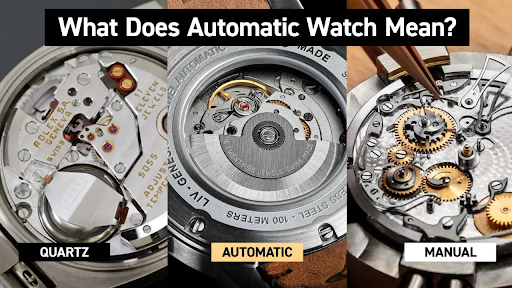Timeless Motion: Understanding What Is an Automatic Watch
Greetings and welcome to this comprehensive guide on what is an automatic watch, your go-to resource for exploring one of the most fascinating innovations in horology. Whether you’re a first-time buyer or simply curious about how these marvels of engineering function without batteries, this article will walk you through everything you need to know. From how automatic movements work to whether they’re suitable for occasional wearers, we’re diving deep into all aspects of what is an automatic watch.
Introduction to Self-Winding Watches
To start, let’s break down what is an automatic watch in simple terms. An automatic watch—also known as a self-winding watch—is a type of mechanical timepiece that harnesses the natural movement of your wrist to power itself. Unlike quartz watches that rely on batteries, automatic watches are powered by kinetic energy. This makes them not only environmentally friendly but also mechanically elegant.
The keyword here is “self-winding.” These watches don’t require you to manually wind them every day—your wrist does the work for you. That’s what makes understanding what is an automatic watch so compelling for watch enthusiasts and casual wearers alike.
The Mechanical Foundation
To grasp what is an automatic watch, you need to understand how traditional mechanical watches work. In a basic mechanical watch, a mainspring stores energy when you turn the crown. This energy is then gradually released through a series of gears and components, which keeps the hands of the watch moving.
Automatic watches build on this principle but add a clever twist: they include a rotor—a semicircular piece of metal that spins as your wrist moves. This rotor winds the mainspring automatically, eliminating the need to wind the watch manually every day.
So, when you’re asking yourself what is an automatic watch, think of it as a mechanical watch that doesn’t need your constant attention.
Behind the Rotor: How Movement Creates Power
Let’s dig deeper into what is an automatic watch by examining the internal mechanics. Inside the case, the rotor is connected to the gear train, which, in turn, is linked to the mainspring. When you move your arm, the rotor spins and winds the mainspring. The coiled spring stores this energy and gradually releases it to power the watch.
High-end models use rotors made of heavy materials like tungsten, gold, or platinum to maximize kinetic energy. Some also use ball bearings to allow smoother rotation and enhanced durability.
In short, understanding what is an automatic watch means appreciating this self-sustaining cycle of motion and energy conversion.
Will It Wind Forever?
One of the most frequent concerns among people learning what is an automatic watch is whether it winds forever. The answer is: not quite. If you leave your automatic watch untouched for an extended period—typically 36 to 48 hours—it will eventually stop running. When this happens, you’ll need to either manually wind it or give it a shake to get it going again.
That said, many modern automatic watches now include the option to manually wind them through the crown, giving you more flexibility if you’re someone who doesn’t wear a watch every day.
Understanding what is an automatic watch helps set realistic expectations for how they function and perform over time.
Viewing the Magic Through the Case Back
A notable feature that watch collectors love—especially when learning what is an automatic watch—is the exhibition case back. This transparent back allows you to see the intricate movement of gears, springs, and the spinning rotor in action.
It’s a visual feast and makes wearing an automatic watch not just practical but also a joyful experience. It’s one of the subtle yet strong appeals of grasping what is an automatic watch—you get to wear a piece of mechanical artistry on your wrist.
Occasional Wear: Good or Bad?
If you’re wondering what is an automatic watch good for when you only wear it occasionally, the answer depends on your habits. These watches are ideally suited for daily wear because consistent wrist motion keeps them powered.
However, for occasional wearers, a watch winder can be a handy tool. It mimics wrist movement and keeps the watch running even when it’s not being worn. That way, you don’t have to reset the time and date every time you pick it up.
Again, knowing what is an automatic watch includes understanding its strengths and how to maintain it based on your lifestyle.
Are Automatic Watches Better Than Quartz?
When you understand what is an automatic watch, the comparison with quartz watches naturally arises. Quartz watches are powered by batteries and are generally more accurate. However, they lack the craftsmanship, character, and self-sufficiency that define automatic timepieces.
Automatic watches appeal to people who appreciate traditional watchmaking, sustainability (no batteries!), and mechanical ingenuity. They often last longer than quartz watches and don’t require frequent servicing if well-maintained.
So, when deciding between quartz and automatic, consider not just accuracy but also what what is an automatic watch means to you in terms of heritage and experience.
Pros and Cons of Automatic Watches
If you’re still asking what is an automatic watch and whether it’s right for you, consider these pros and cons:
Pros:
- No batteries required
- Environmentally friendly
- Longer lifespan
- Aesthetic appeal with visible movements
- Rich craftsmanship
Cons:
- Slightly less accurate than quartz
- Requires regular wear or winding
- Usually more expensive
Being aware of these factors helps you make an informed decision about what is an automatic watch and whether it fits your lifestyle.
How to Maintain an Automatic Watch
Maintaining your watch is crucial once you understand what is an automatic watch and how it functions. Follow these basic tips:
- Wear it regularly to keep it running smoothly
- Store in a watch winder if not worn often
- Service every 3–5 years by a professional
- Avoid strong magnetic fields that can disrupt the movement
- Keep it clean and dry to extend its longevity
FAQs
1. What is an automatic watch in simple words?
An automatic watch is a mechanical timepiece that winds itself using the motion of your wrist, eliminating the need for daily manual winding or batteries.
2. Can an automatic watch stop if not worn?
Yes, it can stop after 36–48 hours of inactivity. It needs wrist movement or manual winding to start again.
3. Is an automatic watch better than quartz?
Not necessarily better, just different. Quartz is more accurate, but automatic watches offer craftsmanship, sustainability, and a traditional aesthetic.
4. Can you manually wind an automatic watch?
Yes, most modern automatic watches can be manually wound using the crown.
5. How long do automatic watches last?
With proper maintenance, an automatic watch can last several decades—some even a lifetime.
6. Do automatic watches require servicing?
Yes, typically every 3–5 years to maintain performance and longevity.
7. Is it OK to shake an automatic watch to start it?
Yes, gentle shaking is fine. Just avoid overly vigorous movements which could damage internal components.
Conclusion
Now that you’ve explored what is an automatic watch from every angle, it’s easy to see why these timepieces remain so beloved. They merge art with science, history with innovation. Whether you wear a watch daily or only on special occasions, understanding what is an automatic watch can transform the way you see and appreciate time itself.
So the next time someone asks you what is an automatic watch, you’ll have more than just a definition—you’ll have insight, history, and perhaps even a newfound appreciation.
Keep an eye for more latest news & updates on Influencers Gone Wild!





